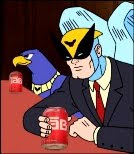Imagine, for the sake of argument, that I have a big bomb. OK, a really big bomb. So big that, should I drop it, it would eradicate you from the face the planet. In response to this threat, you develop your own really big bomb that can eradicate me from the face of the planet. We're both aware of those facts, so we maintain an uneasy peace, made possible by the glory of Mutual Assured Destruction. For decades, the world lived with MAD, as the US and the Soviet Union played the game out during the Cold War. Artists all over the world tried to makes sense of it in serious contemplative works. Stanley Kubrick decided that the only thing to do was laugh about it.
Dr. Strangelove or: How I Learned to Stop Worrying and Love the Bomb started out life as a serious contemplative project. He wanted to make a Cold War thriller and Peter George's novel Red Alert was recommended as a possible adaptation. As Kubrick and George worked on a screenplay, however, the surreal comedic aspects of MAD became evident. Interesting legal sidestep: George would later sue the authors of Failsafe for plagiarism, as it's an awful lot like Red Alert. They settled out of court.
Kubrick's comic nightmare is kicked into action by General Jack D. Ripper, a paranoid commander of US bomber wing. Ripper orders his bombers, which are nearly constantly stationed a couple of hours from their Soviet targets, to proceed with an attack. Why? Because of a communist plot to dilute the "precious bodily fluids" of Americans. Needless to say, the Soviets are not attacking. The functionless voice of reason to Ripper's paranoia is a British officer, Lionel Mandrake (Peter Sellers, in the first of three rules), who tries unsuccessfully to recall the bombers.
The action shuttles between Ripper's office, where Mandrake tries to come to terms with the General's insanity; one of Ripper's B-52s heading towards its Soviet target (commanded by a bravura Slim Pickens as the ultimate Texas cowboy); and the War Room, where the president (Sellers again) tries to stop the inevitable, with aid from the not altogether helpful General Turgidson (George C. Scott), who thinks this presents an opportunity to win a war, and the mysterious ex-Nazi scientist, Dr. Strangelove (Selllers once again).
Needless to say, it doesn't end well. By the time Pickens famously rides one of his bombs to the ground like an oversized bronco, the world as we know it will cease to exist. Along the way, we get Turgidson's helpful sense of scale (pushing his scheme to launch a full attack with "acceptable" American casualties of "no more than 10 to 20 million killed, tops ... depending on the breaks") and the president's famous plea to Turgidson while he squabbles with the Soviet ambassador, "Gentlemen, you can't fight in here! This is the War Room."
As you can tell just by the names of the characters, Strangelove is broad satire. It takes all the stereotypical characters one might find in such situations if they were dramas and turns them to 11. Yet, Kubrick never loses sight of the fundamental absurdity of the era. What's more, for all the dark humor, it points out how unbalanced or just ineffective leaders can make a bad situation even worse. Which is partly why Strangelove is as funny - and as terrifying - today as it was back then.
UPDATE: In his original New York Times review of Strangelove, Bosley Crowther wrote:
Stanley Kubrick's new film, called "Dr. Strangelove or: How I Learned to Stop Worrying and Love the Bomb," is beyond any question the most shattering sick joke I've ever come across.That's about right.









2 comments:
Strangelove is absolutely brilliant. But I think it remains funny and terrifying only to those of us who lived through some of the Cold War era. I'd guess that anyone Gen Y or younger wouldn't have the proper frame of reference to truly appreciate what Kubrick satirizes in it.
It's an awesome film!
Post a Comment